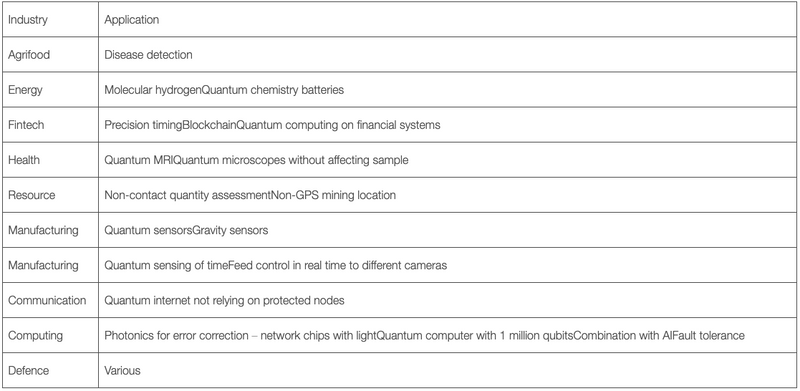Quantum mechanics is here for all

In the recent conference in Sydney during February 2022 by Quantum Australia there was discussion on how Australia is in a good position to exploit the use of Quantum Mechanics in a wide range of industries.
This conference follows the Australian Federal Government’s announcement in November 2021 to identify quantum mechanics as an industry that is to be part of the investment part of the government’s plan to protect and promote certain critical technologies in the country’s national interest.
Australia’s Chief Scientist Dr Cathy Foley has been appointed to lead the National Quantum Strategy, aimed at better integrating industry and government activities. This is based on the recommendations of CSIRO’s Quantum Technology Roadmap that she was instrumental in creating.
This approach will bring together commercial, research and national expertise. It could be considered that the two main experts in the field are quantum mechanic physicists and quantum programmers. However, many others are in industries that need and will use the technology in a “black box” manner and many others are in ancillary fields that enable the technology. Therefore a broad range of people need to take notice of this development.
Since my time as a student of quantum mechanics under Professor Wagenfeld at RMIT, in 2000 the science and industry has dramatically taken off. Now working as a patent attorney specialising in the field of Physics, it is clear that patents are critical to the success of the industry here in Australia. According to a report published by incoPat, the companies that filed the highest number of quantum computing invention patent applications globally until September 2020 include:
- IBM (filed over 500 patents)
- D-Wave (over 400)
- Google (over 350), and
- Microsoft (over 250)
Clearly patents are not able to monopolise the new science in itself, (quantum interference is not patentable in itself) but the novel and inventive application of the science are generally patentable as well as the ancillary technologies (such as deep refrigeration) that are required to enable the science.
Although some elements of the industry are open source, this is generally to allow connection of the users of the technologies to interconnect with back end super quantum computers.
The range of industries in Australia that are developing the benefits of quantum mechanics at present, include:

Operators in the field include:
- Large multinational firms such as:
- IBM Quantum
- Microsoft, and
- Google Quantum AI which is a research effort by the team at Google that is advancing the state of the art of quantum computing and developing the tools for researchers to operate beyond classical capabilities.
- Specialist companies such as:
- Bluefors which manufactures dilution refrigerator measurement systems and has a strong focus on the fields of quantum and nanotechnology,
- Coherent Scientific specialises in the supply of lasers, detectors, optical and atomic force microscopes, nanoinstruments and other optics related equipment for photonics and quantum applications in the physical sciences, and
- QuintessenceLabs which is a global leader in quantum cybersecurity, offering a suite of unrivalled cybersecurity solutions for today and tomorrow.
- Australian science organisations such as:
- CSIRO, and
- Australian Research Council Centre of Excellence for Engineered Quantum Systems (EQUS).
- Australian education and research including:
- ANU
- The University of Melbourne, and
- Sydney Quantum Academy (SQA) which is a unique partnership between Macquarie University, UNSW Sydney, the University of Sydney and University of Technology Sydney – and is supported by the New South Wales Government to build Australia’s quantum economy.
- Education platforms such as
- Qiskit
- Q-CTRL , and
- Quantum Science and Technology – A multidisciplinary, high impact journal of the IOP devoted to publishing research of the highest quality and significance covering the science and application of all quantum-enabled technologies.
- AU start-ups such as:
- PsiQuantum that is an Aussie-led quantum computing start-up in Silicon Valley based on photons for use in building a fault-tolerant quantum computer,
- Keysight Technologies that provides True-Q software delivering critical solutions for both small- and large-scale quantum computers through a Python API,
- Quantum Brilliance Pty Ltd—the global company developing quantum microprocessors based upon diamond that will make quantum computing ubiquitous, and
- Redback Systems, an innovative spectrometer startup that builds fundamentally powerful scientific instruments that challenge widely adopted tools.
- PhD students that are working with industry and/or academia
- Technologists that are required to be enablers
It was stated often during the conference that an important characteristic that Australia can take advantage is its innate ability to collaborate. Australian developers, academia, companies and technologists are open to collaborating. In Quantum Mechanics, it’s not going to be possible for one company or organization to operate alone and fulfil all the requirements of a project including providing the back-end quantum computer, providing the refrigeration, developing quantum components as well as those undertaking projects that connect in a “black box” manner to take advantage of the technology. Therefore, an unexpectedly wide range of industries will need to connect with Quantum Mechanics technology in the same way many industries have now adapted AI solutions to their needs.
At Baxter IP we have a broad range of expertise from physicists to a range of different electrical, electronic, computational, aviation engineers and scientists who can work with you to assist your project with the benefits that patents provide.
Specifically, we can assist in:
- Consideration of inventorship/ownership of new ideas
- Review of university and research IP policies to help assess ownership of IP
- Searches of relevant patent documents to assist research, patent protection, and assess freedom to operate
- Identifying relevant parties that could be worthwhile for collaboration, and
- Filing of patent applications to protect new quantum mechanics or allied technologies.
Please do reach out to Martin Earley – martin.earley@baxterip.com.au if you would like to learn more about how Baxter IP may be able to help you in this technology area.
